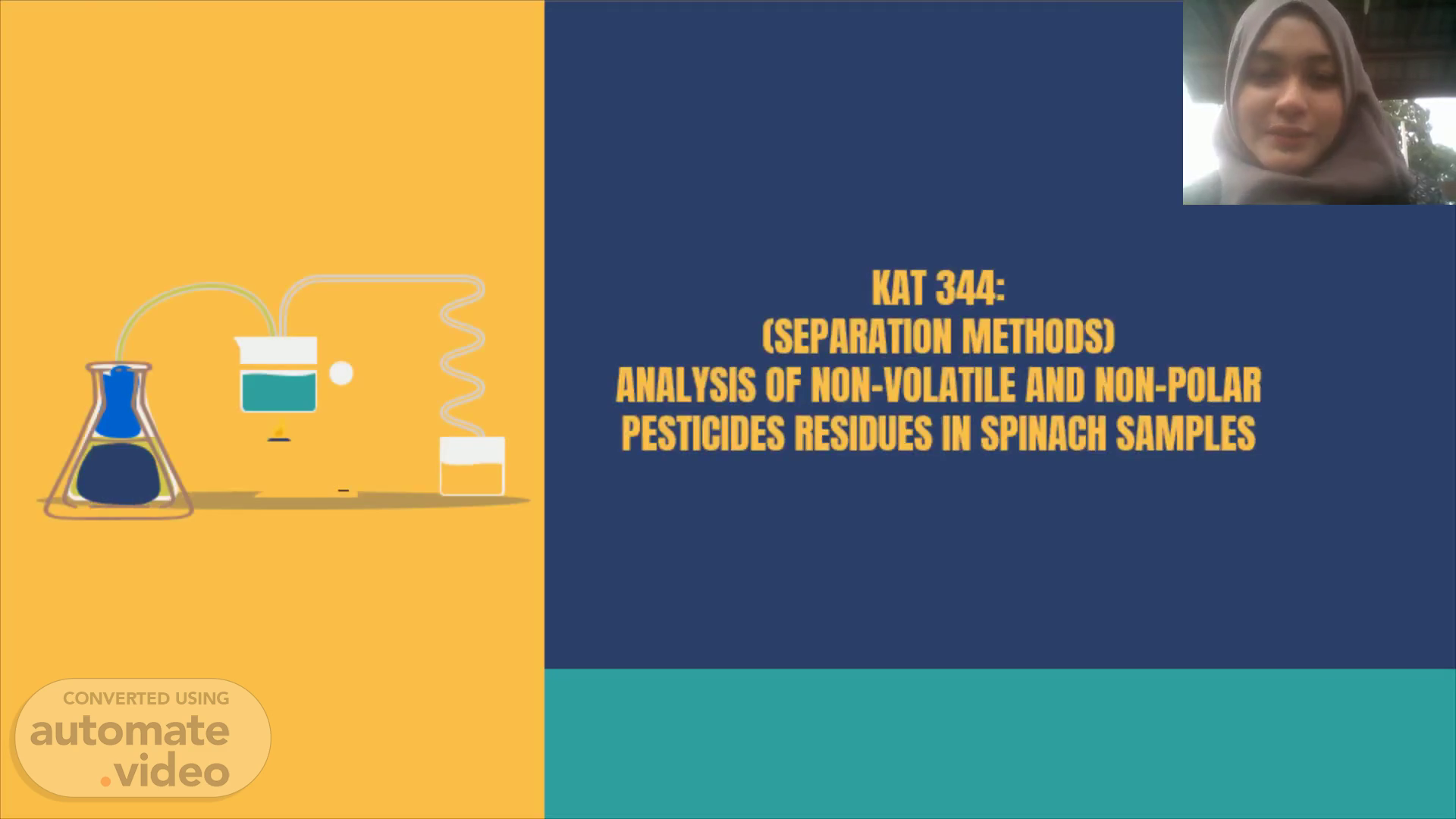
KAT 344: (SEPARATION METHODS) ANALYSIS OF NON-VOLATILE AND NON-POLAR PESTICIDES RESIDUES IN SPINACH SAMPLES
Scene 1 (0s)
KAT 344: (SEPARATION METHODS) ANALYSIS OF NON-VOLATILE AND NON-POLAR PESTICIDES RESIDUES IN SPINACH SAMPLES.
Scene 2 (18s)
KAT 344: (SEPARATION METHODS) ANALYSIS OF NON-VOLATILE AND NON-POLAR PESTICIDES RESIDUES IN SPINACH SAMPLES.
Scene 3 (38s)
Function, Characteristics & Eplanation. Result & Discussion.
Scene 4 (56s)
Principle of extraction. Known as an Extractive Workup method, it is used to purify compounds and separate mixtures of compounds, such as when isolating a component from a reaction mixture. Known as an Extractive Workup method, it is used to purify compounds and separate mixtures of compounds, such as when isolating a component from a reaction mixture. The LLE principle Distribution Coefficient, ?? = ??????. ?? ?????? (??????? ?ℎ???) ??????. ?? ?????? (??????? ?ℎ???).
Scene 5 (1m 44s)
• Pest-controlling substances • The majority of pesticides are designed to protect plants. Known as Crop protection In general, it shields plants from weeds, fungi, and insects., and insects. •.
Scene 6 (2m 3s)
PESTICIDES RESIDUE. In the developing world of industrial agriculture, this is an important method for food analysis. Product quality and regulatory standards are strictly enforced in intensive agriculture. To ensure that crops are free of contaminants and have incredible nutritional value in markets all over the world while staying within acceptable limits..
Scene 7 (2m 43s)
OBJECTIVE. To separate the analysis of interest from interfering sample components and concrete it. To make the analytes compatible with the instrument, they must be converted. To provide a suitable concentration for the detection or measurement of analytes of interest...
Scene 8 (3m 8s)
Chosen Sample Preparation. processes in which a representative piece of material is extracted and prepared for analysis from a larger amountprocesses in which a representative piece of material is extracted and prepared for analysis from a larger amount.
Scene 9 (3m 27s)
Principle of extraction. Sample preparation also known as sample treatment as seen in Figure 1, is required for most chemical studies since the sample obtained cannot be used for direct analysis. Filtration may be required to remove insoluble components from solids, for example, by dissolving the solid in water or digesting it with acid..
Scene 10 (3m 46s)
INSTRUMENTATION (HIGH PERFORMANCE LIQUID CHROMATOGRAPHY).
Scene 11 (4m 13s)
HPLC Reversed phase C18 columns liquid chromatography..
Scene 12 (4m 44s)
Principle of extraction. The partitioning of components between two phases, both of which are present in liquid form, results in the separation of components from the sample..
Scene 13 (5m 3s)
DETECTOR CHOSEN. UV- Chromohore / UV Absorbance There are 3 types: fixed wavelength, variable wavelength, photodiode array detectors often makes use of 254nm & 280nm lines from mercury source due to many organic functional groups absorb in this region Provides good sensitivity for light-absorbing compounds Is simple to use and stable. A common detector for HPLC analysis. ..
Scene 14 (5m 32s)
Stationary phase. Column C18 Packing consists of small silica or polymer particles containing a uniform pores network into diffusion analyte.
Scene 15 (5m 56s)
Mobile phase. They are effective analyte solvents. It is possible that any interactions [based on polarity or charge] will be prevented. It is possible that any interactions [based on polarity or charge] between the analytes and the stationary phase surface will be prevented..
Scene 16 (6m 16s)
MOBILE PHASE DELIVERY A mobile phase is pumped under high pressure from one or several reservoirs and flows through the column at a constant rate. For normal phase separation eluting power increases with increasing polarity of the solvent but for reversed phase separation, eluting power decreases with increasing polarity. A degasser is needed to remove dissolved air and other dust & particulate matters from the solvent.
Scene 17 (6m 35s)
MOBILE PHASE. For normal phase separation eluting power increases with increasing polarity of the solvent but for reversed phase separation, eluting power decreases with increasing polarity. For normal phase separation eluting power increases with increasing polarity of the solvent but for reversed phase separation, eluting power decreases with increasing polarity. For normal phase separation eluting power increases with increasing polarity of the solvent but for reversed phase separation, eluting power decreases with increasing polarity. For normal phase separation eluting power increases with increasing polarity of the solvent but for reversed phase separation, eluting power decreases with increasing polarity..
Scene 18 (6m 54s)
Principle of extraction. Sample preparation also known as sample treatment as seen in Figure 1, is required for most chemical studies since the sample obtained cannot be used for direct analysis. Filtration may be required to remove insoluble components from solids, for example, by dissolving the solid in water or digesting it with acid..
Scene 19 (7m 13s)
Principle of extraction. Sample preparation also known as sample treatment as seen in Figure 1, is required for most chemical studies since the sample obtained cannot be used for direct analysis. Filtration may be required to remove insoluble components from solids, for example, by dissolving the solid in water or digesting it with acid..
Scene 20 (7m 42s)
Detecting pesticide residue using the HPLC method.
Scene 21 (8m 6s)
BIBLIOGRAPHY. . W. (n.d.). HPLC Separation Modes . Waters. Retrieved December 15, 2021, from https://www.waters.com/waters/en_US/HPLC-Separation-Modes/nav.htm?cid=10049076&locale=en_US UV CHROMOPHORE . (n.d.). ResearchGate. Retrieved February 4, 2022, from https://www.researchgate.net/figure/Absorption-spectra-and-chromophores-of-red-light-in-red-blue-light-in-blue-and-UV-B_fig4.
Scene 22 (8m 25s)
THANKS. Does anyone have any questions?. Please keep this slide for attribution.